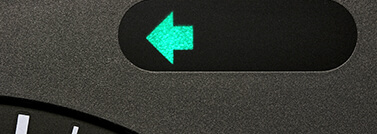How to turn left from a major road into a minor road?
Firstly, identify the road you want to turn into as early as possible. Look out for road signs on the approach or even cars exiting/entering the road on the left. If you are using satellite navigation on the driving test then glancing at the sat nav and listening to the audio directions may help. See the Sat nav section/independent driving for more information.
The importance of recognising your turn early is so you can apply the MSPSL routine in good time.

Applying the MSPSL routine for turning left
Mirrors
Check your interior and left door mirror as a minimum requirement on the approach. In busy traffic you may need to check them more than once.
Signal
It’s important you put a signal on in good time so other road users/pedestrians can benefit. Be careful of putting your signal on too early/too late.
Position
If you are on a fairly wide road, then it’s a good idea to adjust your position slightly to the left. This reinforces where you are going and often allows other vehicles to pass you more easily (ie; motorbikes). Most roads you should aim to be roughly 1-2 feet away from the kerb on the approach.
Speed
Only start applying the brake once you know the activity behind you is driving sensibly. Your mirror checks early on will confirm this. Assuming it’s safe behind you, start using the footbrake first, only push the clutch down to change gear nearer to the corner. As a general rule on a 30mph road (assuming you are in 3rd gear) you should use the brake to slow down to approximately 10-15mph before declutching and deciding which gear to go down to. If you believe you can complete the left turn at 10-15mph then select second gear. If the left turn is sharp/blind then it’s quite common to continue braking and select first gear once the vehicle speed is less than 5-7mph.
Look
You’ve been looking on the approach early on, but do you know it’s safe to turn into the new road? Look out for pedestrians and parked cars especially. Once you have entered the new road, you should check your interior mirror and usually right door mirror to see what’s behind you in the new road.
Top tips
-
Mirrors: Sometimes you may see a vehicle behind you following too close. If you see this early on, you can and should start your routine earlier. By putting your signal on, adjusting your position and slowing down gradually there will be less surprise to the person following close behind, therefore less chance of you getting hit from behind.
-
Signal: As a general rule you should put your signal around 10 car lengths away from a left turn (if unsure, consult your instruct, some junctions will require earlier and some the signal may need to go on later).
-
Position: Never adjust your position to the left if it’s not possible (narrow road) or if you have a hazard coming up behind you, for example a cyclist in slow moving traffic.
-
Speed: Avoid putting the clutch down too early. This is called coasting and may cause the car to speed up/have less control. Listen to the noises of your car engine, when the engine revs become lower (usually 1,500-2,000 revs) then put the clutch down for a lower gear.
-
Look: Never turn into a road and then look. If you can’t see into the new road, that means you need to be slow enough that is something is there, you can stop in time safely. This requires anticipation and defensive driving which are two skills for life that we can never stop learning enough about.